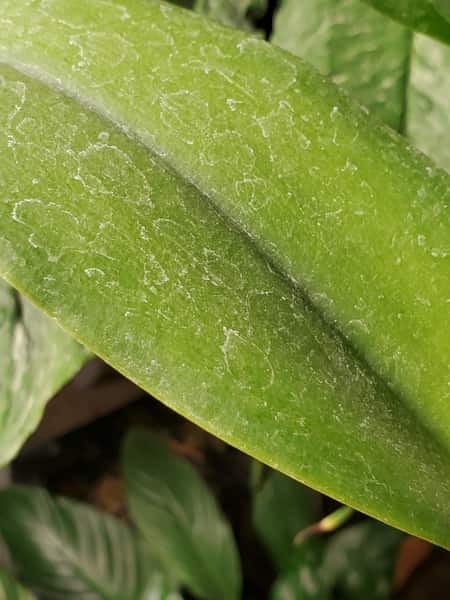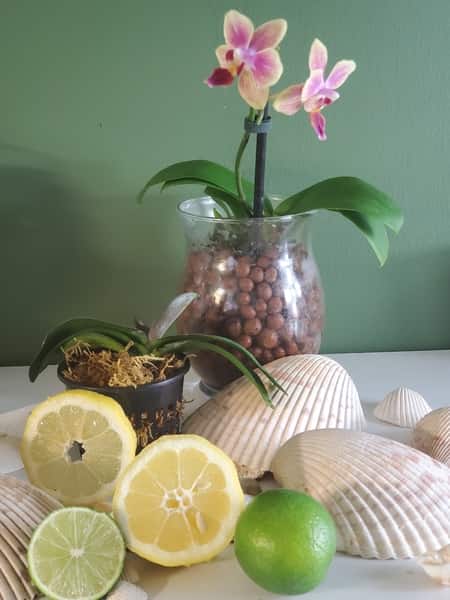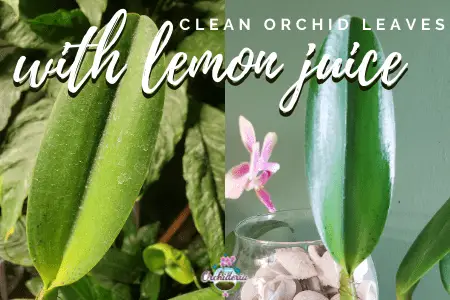Have you ever seen those beautiful orchid leaves that almost shine so much they look fake? Don’t get me wrong, they’re gorgeous, but how do you clean an orchid leaf to make it shine like that? They’re so reflective and healthy looking, it’s like the orchid’s leaves are polished.
What is the best way to clean and polish orchid leaves so they shine? To remove the mineral deposits or dust on orchid leaves, wipe the leaf clean with one of these solutions diluted with water: mayonnaise, lemon, mild dish detergent, baby shampoo, vinegar, isopropyl alcohol, or distilled water. Milk also is beneficial in cleaning orchid leaves.
Image Credit: Orchideria © 2020 All Rights Reserved

Notice the Mineral Deposit Build-up on the Orchid Leaf
Before we look at these methods one by one, what are the benefits of cleaning the leaves?
You might think like I did when I first grew my orchid indoors, that a little dust here and there wouldn’t harm the leaves.
Once I tried to clean them with plain water, but after the leaves dried, the white spots didn’t go away.
I knew then it wasn’t just dust, and those unruly, stubborn white spots are what prompted me to look into how to clean orchid leaves.
Not only does the orchid look healthier, clean orchid leaves provide a reflective surface that will aid in keeping the heat waves off the leaf, and it also keeps the pest down. This last item is only because you can see them better, as they stand out on a cleaner leaf.
Orchids breathe through their leaves, exchanging gases through the stomata (or pores). This gas exchange can become interrupted or deficit when the orchid’s leaves are dirty, and not to mention that it’s just unsightly. Dust, salt build-ups, hard water stains, mineral residues, excess fertilizer, leftover pesticides, or even bugs that lay on the orchid’s leaves are interfering with proper gas exchange and can harm your orchid.
Method for Cleaning Orchid Leaves # 1: Mayonnaise
Mayonnaise is made up of homemade items that you probably have lying around your house. In fact, homemade mayonnaise is much tastier and has fewer chemical additives. By using lemon juice or vinegar, egg yolk, oil, and a touch of salt, you can make mayonnaise at home.
How does mayonnaise clean the leaves? With the acidic properties in the lemon (lime can also be used) the mineral deposits, like calcium and magnesium, are dissolved making them easier to clean. If you are making mayonnaise at home just for orchid use, omit the salt.
Acidic substances dissolve the salts and calcium, and that is why the lemon juice in mayonnaise makes it work so well. The egg yolk adds extra shine, (which other methods will omit or lack) after the mineral deposits have been broken down and cleaned off.
One tip when cleaning orchid leaves with mayonnaise: never use mayonnaise on the bottom of the orchid leaf. This is where the stomata are and most of the gas exchange occurs. You can wipe down the top part of the leaf, and the mayonnaise will give your leaf that extra shine you’re looking for, but never use mayonnaise on the bottom.
The other methods are better for the bottom of the leaf since they will not harm the stomata as much as mayonnaise will.
Method for Cleaning Orchid Leaves # 2: Diluted Lemon or Lime Juice
I’ll use lemon interchangeably with lime, since the properties of both are similar. It doesn’t matter in this case which one you choose since the results will be the same. This is the most natural approach to cleaning the leaves since all you have to do is squeeze a lemon and dilute it in water.
I don’t recommend using store-bought lemon juice since you’ll be adding more chemical additives that will provoke future stains on the orchid leaf. Another tip about lemons: don’t clean the leaves and place the orchids in the sun.
This goes for personal health too. Never squeeze fresh lemon juice and go out in the sun. The chemical reaction will burn your skin worse than a normal sunburn would. Lemon juice amplifies the light, making whatever it is in contact with more susceptible to burn. Always wash your hands after squeezing lemon and taking a walk in the sun.
Although not related to the sun, be careful with lemons and orchids in general. I made this mistake once when I tried to water with lemon juice. I had read somewhere that adding lemon slices to the water you use for orchids would increase the acidity.

Image Credit: Orchideria © 2020 All Rights Reserved
The Acidity in Lemons Cleans Orchid Leaves
Since my water is extremely hard, I tried it.
At first, the orchid was fine, but after three days, the first bud shriveled. Then the second. Bud after bud fell off the orchid. So always test on a small portion of the leaf.
Lemon juice is one of the only methods that is approved to use on the underside of the leaf. The acidic is not that harmful to close the stomata or damage them.
Just don’t wipe vigorously or press the cloth too hard against the bottom part of the leaf.
Method for Cleaning Orchid Leaves # 3: Diluted Vinegar
Vinegar will have the same effect as the lemon and lime do, but some brands tend to be too acidic for orchids, ranging in a pH of around 2.5. Since most epithetic orchids prefer to have water around 5.5 to 6.5, this is an extreme acidic overload. Terrestrial orchid will near die if you offer them diluted vinegar, since their pH preference is more alkaline, around 7.5.
Vinegar comes from a French word meaning sour wine, and its name holds to be true. This method will dissolve most all deposits from mineral residue that lemon juice couldn’t. Just don’t go overboard with the vinegar.
Beware: vinegar may cause more damage than harm. If you don’t have big, juicy lemon laying around the house but have some vinegar in the refrigerator, then test it on one orchid leaf and see how the orchid reacts.
Wait one week before using vinegar on the other leaves. Orchids are slow growers and react slowly to the change in their environment. It might be that after a few minutes the leaves look fine, but after a few days, the chemical reactions start to become visible.
Do not use vinegar on the underside of the leaf.
Method for Cleaning Orchid Leaves # 4: Alcohol
Isopropyl Alcohol is not the best method for cleaning orchid leaves, but it still does work. In this method, the aim is not mineral deposits but pests and insects.
Most pests that attack orchids are extremely tiny and hard to see. We only notice them when awful black spots or dark green sunken holes appear on the orchid leaf. Fake spider webs form around the stem and before we ever suspect that our orchid could have a pest problem.
Alcohol will keep the pests from proliferating, killing the ones that are already present. Cleaning the leaves with isopropyl alcohol is one of the first things you’ll want to do when unboxing orchids, double-checking any possible problems.
Bacteria, on the other hand, are not visible like pests and insects are. Cleaning the orchid leaves with alcohol will kill the bacteria before it has time to spread, causing those horrible spots that ruin the leaves. Do not use alcohol on the underside of the orchid leaf.

Before and After Using Lemon To Clean Orchid Leaves
In this picture, the same orchid leaf is shown before and after adding lemon to clean the leaves. Notice the purple spots on the leaves near the base of the leaf. These are due to high lighting, and if your orchid has them, read this article that talks about purple spots. The grayish-white spots have all gone, leaving the leaf with a bright, reflective shine.
Method for Cleaning Orchid Leaves # 5: Dish Detergent
The same cleaning products you use to wash your dishes can be diluted to clean orchid leaves. In this case, you’ll want to use 10% detergent to 90% water. The solution will cause minor bubbles on the leaf which don’t harm the orchid. As long as you wipe off the excess after you have cleaned the leaf, this method works well.
If you leave the solution on the leaf to dry naturally, evaporating into the air, the detergent will cause new, dusty-gray marks on the leaves. This method can also be used on the underside of the leaf, since it is so mild that it won’t harm the breathing mechanisms.
Method for Cleaning Orchid Leaves # 6: Baby Shampoo
Ahh… my favorite. An orchid that smells like a baby—what else could one want? Ok, that’s a little exaggerated, but the baby shampoo works just like the detergent method listed above, but the upper side is that you don’t have to dilute it as much.
With the dish detergents fabricated to remove tough dirt and grease stains on pots and pans, the chemical formula is more powerful to orchids. Baby shampoo is better in the sense that the chemical formula is less aggressive but still gets the job done.
Method for Cleaning Orchid Leaves # 7: Water
You might be wondering why I left water for last. Sometimes what has accumulated on the top of your orchid leaf is not chemical residue or leftover fertilizer. Sometimes it’s just plain, old dust.
In all the methods mentioned above, the aim is for residues that when wiped off with water will just appear again after the leaf dries off. The solution then is to use more powerful substances that break down the mineral deposits, causing the white marks.
But if your orchid leaf just has a fine layer of dust on it, then it’s prejudicial to use anything stronger than water. It would be like bringing a torpedo to a knife fight. If you use tap water, in time, white marks will appear and you’ll have to use the chemicals mentioned in the methods above. Start with water and see how it reacts.
If the marks come back when the water has evaporated, move on to stronger methods.
Other Store-Bought, Chemical Solutions
There are chemical solutions that you can buy, like Leaf Shine, which make your orchid look like the plastic ones we buy in thrift shops. I have never used this so I can’t recommend it either positively or negatively.
I have read that you shouldn’t put Leaf Shine on orchid leaves just before going to a contest, and even though the author never said why, I wish they had. That would make an interesting story.
If you happen to place one of these items on your orchid leaf and it wilts, read this article about wilting orchid leaves. It might not be the product you used, but another underlying cause.
Don’t Stop Learning!
If you want to be included in more information and get a 14-page fertilization guide, please sign up for my newsletter. I don’t spam, but send emails out bi-monthly with some curious topics of interest. If you want more information, click here to go to a specific page on this website where I explain it more in detail.

Also, if you are looking for an orchid journal to keep your notes specifically about orchid care, check out my 2 solutions for that on this page. If note-keeping isn’t your thing, then there is a free excel spreadsheet that you can download. Click here for more information on how to do that.
If you subscribe to my newsletter, I will send you a 14-page guide on the main tips of orchid fertilizer. It is downloadable and you can print it out on your computer. I designed the guide to double up as a coloring book, just to make it fun.
Further Reading Suggestions:
Don’t just take my word for what is written here. Continue researching other articles about cleaning orchid leaves, because everyone has a different point of view and unique techniques that work for them. Here is another suggestion from a different websites if you’d like to continue your research on cleaning orchid leaves:
–Title: “Polishing Your Orchid Leaves ” written by Mel Waki, published on Honolulu Orchid Society Website talks about general guidelines on using mayonnaise for cleaning orchid leaves.
” written by Mel Waki, published on Honolulu Orchid Society Website talks about general guidelines on using mayonnaise for cleaning orchid leaves.
I hope my article was helpful, and if it did provide any useful information, please leave a comment below. I love to interact with other orchid enthusiasts, whether it be professional or just starting. We all have different methods to do things and maybe you have a method that I didn’t mention here. We all have tons to learn and we can do that through sharing!
Happy cultivating!


Thank you for another interesting and helpful article. Could you please add the dilution proportions for the various methods? How much lemon juice to how much water? I think I have will try this one first.
Hi Carol,
Thanks for your comment. I usually go half-and-half with the water and the lemon. Any stronger than that, I feel it could cause more harm than good.
-Amanda
Thankyou for your article . I am new to keeping an orchid si any information is very welcome .
A job h go or tomorrow leaf cleaning .
Mike
Mayonnaise is an old-school wives’ tale that clogs the stomata in plant leaves. Yes, people did this for years, but not necessarily healthy for your plants.
Hi, what if all the leaves have been knocked off? What’s left is looking really dry so I have been watering once a week and spritzing in the middle of the week
Hey Amanda, I love watching your videos! I am a new orchid lover, but I bought four box store orchids and I don’t know how old they are. I want to repot them because they are finished flowering I think. They also are turning brown. I want to free the roots because some of the roots are totally brown and there’s some that look OK. I have so many questions! I’m just learning. Thanks for being there for me.
I never seem to keep my orchid alive, I’ve tried different ways to water it like use warm water or cold water, boiled water cooled, leave to soak in the sink , so many suggestions but my orchid still dies can you help please
Thanks for the thoughtful article. How often do you recommend cleaning the leaves?
Hi Chris,
I wouldn’t clan them too often, only when you see that the build-up is extremely visible. It’s better to rinse them weekly with only water and use these methods as back-up plan. It will depend how many minerals are in your water.
-Amanda
Hello Amanda,
I’ve used 2% milk applied to the top surface of the leaves with a soft oval make-up pad for years.
Works great and looks great.
Best Regards,
Bob
Hi Rob,
Thank you for the comment! I appreciate it.